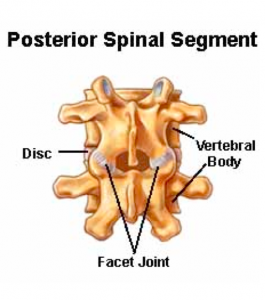Locked facet joints are easy to diagnose and treat

The facet joints are small, cartilage lined points of contact where the bones (vertebrae) in the spinal column meet the vertebrae above and below. See the illustration.They are located toward the outside of each vertebra, and they both allow mobility and yet limit its range. The facet joints that have the most range of motion are those in the neck area below the skull (cervical facet joints) and in the lower spine between the waist and hips (lumbar facet joints). To get a sense of what the joints do, try the following – but not if you feel any discomfort! Stand up and put your hands on -your hips. Now, without straining, bend slightly to the right side, then slightly to the left side. Bend slightly forward, then very slightly backward. Finally, with hands still on your hips, twist slightly to face right, then twist slightly to face left. Come back to center and sit down.
If your facet joints are in good shape, you should have had no problem with these movements because healthy joints permit spinal range of motion while keeping is smooth and cushioned. Nice feeling! However, these small joints can cause big trouble when they are worn out, develop bone spurs, or experience some type of injury or trauma.
One type of injury is a locked facet joint. It’s a kind of dislocation in which a lower vertebra’s facet joint slips “over” the one above it; it can happen on one or both sides of a vertebra. If there is muscle weakness in the surrounding area, or previous injury/locking, it may not take much force to cause it. The simple act of bending or twisting, even a little bit, can create dislocation. Even if your back muscles are strong, exerting more motion or force than the muscles have strength for will push the joint out of place.
Symptoms of a locked facet joint can include:
- Pain
- Inability to move back to your starting position
- Referred or radiant pain away from the joint
- Muscle spasms on the same or opposite side
- Difficulty stretching
- Difficulty moving in any direction
Diagnosis and treatment
In most cases, physical examination by a doctor or physical therapist can identify a locked facet joint. Imaging can sometimes assist with diagnosis, but they are of most value in detecting deterioration or damage that might have contributed to the dislocation rather than the locked joint itself. Treatment consists of a simple, usually painless manipulation to unlock the joint. However, exercises will be prescribed to restore range of motion, and to build muscle strength in that area so that the locking won’t happen again.
Thankfully, a locked facet joint is usually a rare occurrence. If it does happen, it is relatively easy to diagnose and resolve. Other kinds of facet joint pain, especially from degeneration of the cartilage or spinal osteoarthritis, may respond to early treatment with anti-inflammatories, heat or cold applications, exercise and better posture. However, if facet joint degeneration results in chronic pain, especially from compression on a nerve, the Sperling Medical Group offers MRI-guided Focused Ultrasound (MRgFUS), a noninvasive method for deadening the nerves that carry pain messages to the brain. To find out if MRgFUS is right for you, contact the Sperling Medical Group.
_______________________________
iImage from https://www.spineuniverse.com/anatomy/facet-joints-spines-anatomy
- CATEGORY:
- Facet Pain


